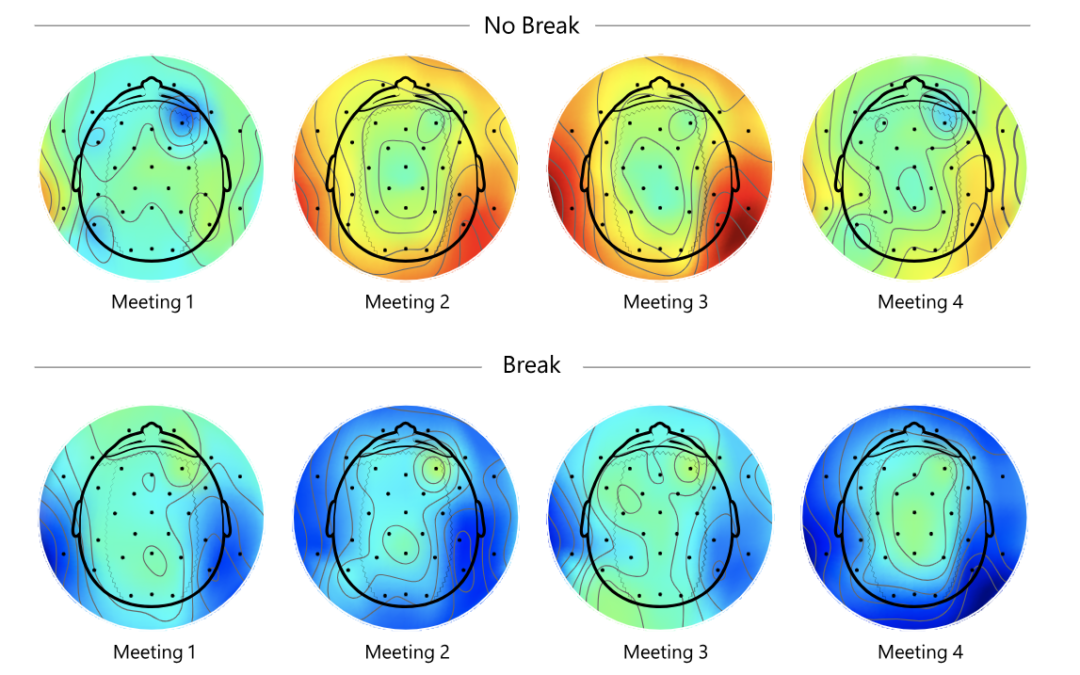Have you ever raced from one video meeting to the next without enough time to pee or eat?
Funny how we used to have time for this when we had in-person meetings, but now that our bathroom is 10 feet from our office, we no longer have the time.
After a long day of virtual meetings, I often feel horrible. Maybe you recognize the feeling. A combination of restless and exhausted, sometimes I feel like I can’t form a coherent thought. Then I wonder if I have early dementia.
Sound familiar?
Ever since the pandemic remote work boom, an increasing number of people have been experiencing the phenomena of virtual meeting fatigue.
And new research proves this is not our imagination—it is a scientifically visible fact.
New brain study by Microsoft
Microsoft’s Human Factors Engineering group recently conducted a study that clearly shows the alarming effects that too many back-to-back virtual meetings have on our brains.
For the study, they hooked up 14 participants to EEG caps (electroencephalogram) to monitor the electrical activity of their brains.
On day one, all the participants went to four back-to-back 30-minute meetings with no breaks.
On day two, all the participants took a 10-minute break between each of the four meetings.
During each 10-minute break, the participants used the meditation app Headspace.
The findings were crystal clear: When participants did not have breaks, the average activity of beta waves—brain activity associated with stress—increased over time and accumulated.
Conversely, when the participants took meditation breaks, beta wave activity dropped and seemed to allow for a “reset,” allowing for people to start their next meeting in a more relaxed state.
The beta wave activity of those who took breaks held steady, with no buildup of stress during the four video meetings.
The graphic from the study (shown in this post) shows the stressful brainwaves in warm colors of yellow and red, whereas the cooler colors of blue and green are associated with relaxation, engagement, and focus.
The study showed that when people don’t take breaks, their stress levels spiked just before the next meeting. The researchers presume this is because people are thinking about the next meeting, suddenly realizing they haven’t really prepared, and they may have to switch gears and think about another difficult topic.
It turns out that back-to-back meetings not only increase stress, but they also harm performance, good thinking, and productivity.
So what can you do?
If you are the leader and influence the meeting schedule, you can act on this research now by setting better schedules. The culture must shift. Save your employees from the onslaught of digital overload and do the following things:
- Schedule breaks between meetings. Not a surprising recommendation given the study. Make sure to have at least 10-minutes between meetings. Start later or end earlier. Give people time to use the bathroom, eat, or recover. Stop on time unless the topic is essential. As the leader it’s your job to set these boundaries for your team.
- Schedule breaks in your day. Even if you have a day without meetings, this research still applies (along with countless other studies on the importance of taking breaks). Make sure you schedule breaks for yourself. Set a timer if needed. Remind yourself how important they are for wellness and productivity, and fight the urge to power through and stay at your computer.
- Have less meetings in general. In his landmark 2016 book Deep Work, computer science professor Cal Newport boldly claimed that the skill of focused thinking would rule the workplace of the future. He advocates for the ruthless eradication of distractions. In my workplace, we’ve tried to practice this by eliminating a lot of meetings and making meetings optional for our team members whenever possible. If you find this difficult, try reminding yourself of the gift you give your team members when they have focused blocks of uninterrupted time to do important work.
- Meetings should have a clear purpose, agenda, and recap. In his famous book Death by Meeting, leadership expert Patrick Lencioni urges leaders to be much more strategic with meetings. Meetings should have a clear purpose, a good reason why each person is attending, and they should have a recap and action plan at the end. Make sure to identify who is responsible for taking action. If you practice these things, you will put yourself into the top 5% of elite leaders with respect to habits with meetings.
- Model the behavior you want. More is caught than taught. As the leader, you must walk the walk or it won’t catch on.
- Do a phone call instead of video. Break away from video and take a walk while talking to a colleague if you can.
- Try meditation. A few years ago I hired an executive coach. He said if I only did two things working with him for the year, he recommended the Headspace meditation app as one of his top two habits. I’ve been using it since 2018 and find it helpful for clearing my head, decreasing anxiety, and better sleep. The Microsoft study used this same app for the study participants.
Have a great weekend!
Parker
*If you have enjoyed Parker’s blog, check out The Next Peak Podcast that Parker co-hosts. We interview successful leaders and discuss research-based principles that help people win in the workplace without compromising the things that matter most—relationships, a life of purpose, and health.
Want more? Suggested Resources Below




